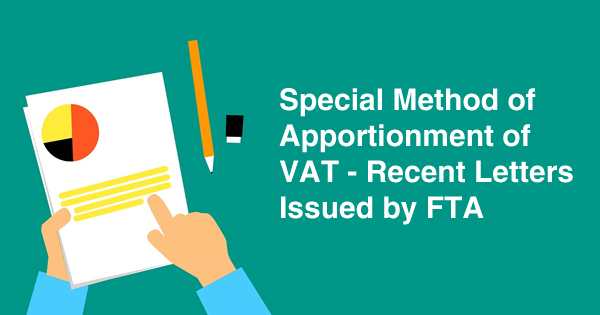
Recently, businesses engaged in Banking and Real Estate have received letters from the FTA asking them to file for the appropriate ‘special method’ of input tax apportionment where the taxpayers believe that the Standard method of apportionment is not reflective of the actual use of goods and services.
Under the UAE VAT Law, all taxpayers that are engaged in supply of both taxable and exempt goods and services should be able to clearly bifurcate the input VAT into two buckets – those used for fully taxable supplies and those used for fully exempt supplies. The bucket used for fully taxable supplies is allowed in entirety and the one that is used for fully exempt supplies is dis-allowed in entirety. However, there are some expenses which are commonly used for the business as a whole and their value towards taxable and exempt is not known or cannot be determined easily. An example of common expense is office rent. Rent is paid for the entire office but the office is used for providing both taxable and exempt supplies. Thus, VAT recovery of the rent paid for the portion of office used for exempt supplies should ideally not be allowed. The challenge is to identify that portion.
The UAE VAT law provides a ‘Standard Method’ of apportioning the input VAT which is based on the value of input VAT that is used for providing taxable and exempt supplies. The Standard Method allows the taxpayers to reverse the value of input VAT (on common expenses) in the ratio of VAT credit that is fully used for providing exempt supplies to the total input VAT credit. This Standard Method is generally ineffective for Banks and Real Estate companies because the reversal is not a correct reflection of the actual use of goods and services.
The FTA released a guide on VAT Apportionment for common expenses and prescribed few methods for companies in the Banking, Real estate and some other sectors to find an appropriate method to reverse the VAT credit. The Guide mandates the taxpayers to select the most appropriate method and get it approved by the FTA. The clarity that is missing in the Guide is whether approval of the FTA is required for the method to be used at the end of the year so that the annual adjustment could be done. Or, is the approval required for the next year when the taxpayer on a periodic basis (based on his return filing period) needs to be make the adjustment.
Recently, some of the organizations and banks have been asked to submit their applications with the FTA before 31 December 2019 where they believe that the Standard Method of Apportionment would not result in the right reflection of the usage of goods and services. The letter also mentions that the ‘The law does not permit businesses to recover VAT at incorrect levels on a period-by-period basis and the FTA is therefore obliged to subject such businesses to a higher level of scrutiny’.
This letter brings in some confusion which needs to be clarified by the FTA:
a) Is the application to be filed by taxpayers for getting the Special Method approved only for making the annual adjustment of 2019?
b) Will the Special Method approved by FTA be applicable for FY 2020 and therefore, the taxpayers in every tax period would need to adjust the input tax basis the Special Method approved?
c) What will happen to the adjustments already made in 2019 for FY 2018. In case the approval was not taken, will there be any penalties?